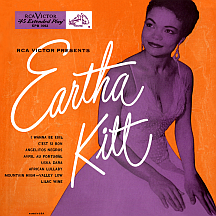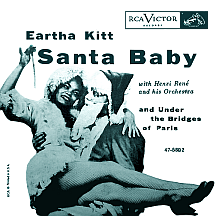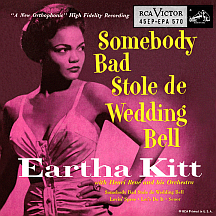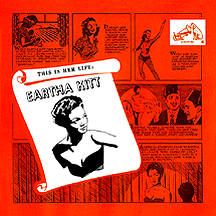EARTHA KITT
At the beginning of her show business career, young Eartha Mae Keitt modified her surname to "Kitt." No four letters could have possibly been more appropriate; the public wasn't yet aware, but Eartha knew its catlike connotation cleverly represented her as a feline femme fatale, an image she relished with purrs and sex-kittenish growls she would use throughout a very long career. As she rose through the ranks, from dancer, to stage performer, to a popular singer with an intentionally international musical repertoire, to an actress inclined towards both comedic and serious turns, achieving as she went no less than two (if not more) career peaks that have confirmed her permanent place as a pop culture icon, Eartha Kitt was always delectably listenable and watchable.
She began life in January 1927 in North, a somewhat confusing name for a small town consisting of a few hundred living on less than one square mile in Orangeburg County, right in the center of South Carolina. Her father's identity is uncertain, though it's suspected he was a white sharecropper who named his daughter Eartha to honor an abundant harvest the year prior to her birth. Her mother, Anna Mae Keitt, a mix of black and Cherokee Indian, abandoned Eartha at an early age and the child spent many years uncertain about her origins. A few different guardians had referred to themselves as her mother, including her "Aunt Rosa," who'd taken over for Anna, and "Aunt Mamie," who she lived with after moving to New York City around the age of eight. Since she'd been brought up in a hard, strict environment, independence was a foreign concept, a dream at best, yet after settling into New York's Harlem neighborhood, the desire to live her life any way she chose became very real.
In 1942 Eartha (known as "Kitty" to her closest friends) attended New York's School of Performing Arts. Just 15 at the time, she had a chance to meet Katherine Dunham, who'd made her mark onstage and in films as a dynamic dancer and choreographer. Eartha was hired as a dancer with Dunham's Ballet Negre dance troupe and performed throughout Europe and the Americas for the next five years. She appeared, uncredited, in the 1948 movie musical Casbah (a remake of the 1937 French film Pépé le Moko and its American version from the following year, Algiers).
During a trip to Paris, Eartha decided to leave Dunham's act and landed a regular job as a singer at Carroll's, a nightclub on the Avenue des Champs-Élysées, a hub of entertainment and fashion where the rich, affluent and artistic-minded assembled. Orson Welles often frequented the club and after seeing Eartha perform, he dubbed her "The most exciting woman on earth," a phrase afterwards quoted often in the press. In 1950, Welles cast her as Helen of Troy in his modernized stage production of Charles Gounod's 1859 opera Faust, in which she performed her own composition, "Yo Creo Yo Tengo un Amor (I Think I Have a Love)." A year later, Eartha made a brief appearance as a cabaret singer in the big screen French-Italian comedy Paris is Always Paris.
Returning to New York, she resumed performing in clubs; a 1952 engagement at Greenwich's Village Vanguard resulted in a packed house at every performance for nearly six months. Having spent a great deal of her teen years in Spanish Harlem, near her home, she'd developed a fondness for Latin beats and melodies. She recorded a Spanish-language single (and EP) for the Seeco label; "Tierre Va Tembla," a torrid number quite unlike the style she was soon to become famous for, was credited to Eartha Kitt and her Afro-Cuban Rhythm.
Theater producer Leonard Stillman caught her act at the Village Vanguard and cast her in his Broadway Revue, New Faces of 1952, presented at the Royale Theatre on West 45th Street. Eartha's breakout stage number, "Monotonous" (written by newcomers Arthur Siegel and June Carroll), established her seductive style in the minds of theatergoers ('I could not be wearier...life could not be drearier...if I lived in Siberia!'); before long she would be familiar to the non-theater-going public (co-star character actress-singer Alice Ghostley also received her share of attention). For "Monotonous," Eartha choreographed her own movements from one chaise lounge to another, placed onstage in a pattern so that while she danced she called out the fourth line of certain verses - 'monotonous!' - followed by a leg kick, body twist or some such suggestive motion. Audiences, not surprisingly, were delighted and word got around Broadway about this fabulous performer. She went a step further and began doing a bolder, later-evening performance at the Blue Angel nightclub, located a few miles away on East 55th Street at the North end of Times Square.
After being approached by several big record labels with ideas out of sync with her style of performing, it was Dave Kapp of the A&R department at RCA Victor (the label that had released her recording of "Monotonous") who offered the freedom to sing whatever she wanted, in any way she liked...though the acting and especially dancing facets of her being would certainly be harder to convey sans visuals! "Uska Dara (A Turkish Tale)," a traditional folk song using Turkish dialect with spoken segments describing, in English, matters of business, romance and rain in the town of Üsküdar, seemed risky as an icebreaker though it did possess some of the exotica flavor popular at the time. The song, arranged by orchestra leader Henri René, with whom she often worked during this time, was a strong seller in the spring of 1953 (it may have sparked a trend: "Istanbul (Not Constantinople)," another Turkish tale of sorts, was a hit for The Four Lads a few months later).
Kitt was quite visible in 1953, with an acting role in an April episode of You Are There, Walter Cronkite's half-hour docudrama series; titled The Conquest of Mexico (1519), it was directed by Sidney Lumet, one of the up-and-coming greats of the motion picture industry. For her next single Eartha interpreted "C'est Si Bon (It's So Good)," a song by Frenchmen Henri Betti and André Hornez with English lyrics by New Yorker Jerry Seelen, and enjoyed her first top ten hit in July. Despite the subtitle, it was sung almost entirely in French ('Crazy, no?') and her sex appeal came through loud and clear.
Much to the dismay of record company executives, Eartha avoided the kind of standard pop fare that gave other singers giant hits. She made a point of taking the eclectic route, making risky song choices, going with whatever struck her fancy, often foreign compositions and songs of a lightly seductive nature. In 1953 and '54 she skirted the novelty fringes with hits like "I Want to Be Evil," a Lester Judson-Raymond Taylor piece that played to her personality: 'I wanna be wicked, I wanna tell lies...I wanna be mean and throw mud pies...I wanna be nasty, I wanna be cruel...I wanna be daring, I wanna shoot pool...and in the theater, I want to change my seat...just so I can step on everybody's feet!' This popular bit of playful malevolence set the stage for her most famous recording.
"Santa Baby," a frivolously-conceived Christmas tune by Joan Javitz and Phil Springer (for him it started a long, successful songwriting career), gave Eartha's materialistic vamp within a chance to stretch the limits. No child ever asked for such a passel of presents: '...slip a sable under the tree, for me...a '54 convertible too, light blue...I want a yacht and really that's not a lot...the deed to a platinum mine...fill my stocking with a duplex and checks, sign your X on the line,' reminding Ol' Saint Nick to '...trim my Christmas tree...with some decorations bought at Tiffany,' topping it all off with '...one little thing, a ring...I don't mean on the phone...' (raise your hand if you already know these lyrics by heart). The song reached number four on Billboard's Best Selling Singles chart the final week of 1953 and has remained popular to this day. A year later she made a sequel, "This Year's Santa Baby," which upped the ante ('...most...of the Florida coast!'), and in 1963 she released an uptempo version of the original that became the blueprint for Madonna's well-known 1987 remake.
Eartha entered 1954 with a calypso-flavored top 20 hit, "Somebody Bad Stole de Wedding Bell" ('Who's got de ding dong?'). Its flip side, "Lovin' Spree," done up by Rene with a country arrangement complete with steel guitar, didn't dull Kitt's suggestive (and still cat-like) delivery and was also popular. At about this time, the breakthrough stage show became a film; her role in New Faces was expanded considerably as she performed six songs onscreen including "C'est Si Bon," "Santa Baby" and the original show-stopper, "Monotonous." Material from this point tended to recycle the established concept in English and other languages (mostly French); she lent her vibrato to Cole Porter's "Let's Do It" (a hit in Australia) and other provocative, Parisian or Manhattanesque tunes like "Mink Shmink," "Mambo de Paree" and "Under the Bridges of Paris" (the "Santa Baby" flip, a top ten U.K. hit in '55) comprised the majority of offerings. One exception, "Honolulu Rock and Roll," issued just as labelmate Elvis Presley was topping the charts in '56, completely misfired, suggesting Kitt should remain queen of her own domain rather than follow incompatible trends.
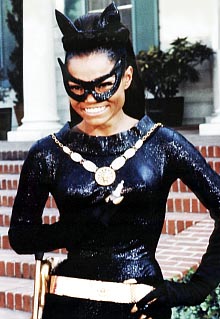
Though the chart hits had stopped, demand for Eartha as a live act escalated, particularly in many countries around the globe. She landed further acting assignments, among them the title role of Salome, a drama about the death of John the Baptist presented as a 1955 installment of CBS-TV's Omnibus, in addition to a 1957 British feature The Mark of the Hawk, co-starring with Sidney Poitier, St. Louis Blues, the '58 bio of jazz and blues forefather W.C. Handy starring Nat "King" Cole, Heart of Darkness (a Playhouse 90 presentation) and the starring role in the Goldwyn Studios feature film Anna Lucasta. In 1958 she left RCA and signed with Kapp Records (founded by Jack Kapp in '54); after several years with minimal returns, she made records for Decca and Musicor while occasionally taking parts in lesser theatrical efforts (1961's Saint of Devil's Island) and higher-profile TV shows (Burke's Law).
An October 1965 episode of NBC's I Spy starring Robert Culp and Bill Cosby (titled The Loser) proved quite a showcase for Eartha's serious side; she was nominated for an Emmy (Outstanding Single Performance by an Actress in a Leading Role in a Drama) but lost to the always-hard-to-beat Simone Signoret (for an installment of Bob Hope's Chrysler Theatre). More strong television guest-shots followed; an April 1967 Mission: Impossible titled The Traitor depicted the lithe 40-year-old Kitt as a cat-like contortionist assigned to break into a building through its ventilation system. Then she assayed her most notorious role as Catwoman on ABC-TV's Batman series starring Adam West. While two actresses had previously played the character (Julie Newmar on TV and Lee Meriwether in the 1966 spin-off flick), Eartha is arguably the most popular of the three for her five consecutive episodes starting with The Bloody Tower in December '67 and finishing with The Joke's on Catwoman in January '68. The big name actors who so zealously portrayed Batman's foes were having a ball the whole time, mocking themselves and relishing the parody. Eartha knew the concept well; viewers connected with her farcical spirit. The role came easily to her: "I didn't have to think about, oh, how do you play a cat. I am a cat!"
She seldom held back when it came to speaking her mind. During a 1965 appearance on The Merv Griffin Show, after guest Phil Spector came dangerously close to some world-class jerkdom, Eartha, also a guest that night, said, "Give someone enough rope and he always hangs himself," prompting thunderous applause from the audience. An invitation to a luncheon held by First Lady Lady Bird Johnson in January 1968 didn't go as well; Kitt's comments about juvenile crime as a protest of the Vietnam War came off to some as a criticism of Mrs. Johnson's efforts against street crime. Suddenly Eartha couldn't get bookings in the U.S. (did Lyndon B. exercise unfair influence?) and had to restrict her concert tours to other countries, mainly in Europe, for the next few years; a government dossier surfaced much later that referred to her as, among other things, a "sadistic nymphomaniac." At least four years passed before she managed to get parts in low budget movies like Friday Foster and TV series like Police Woman, culminating in her return to the U.S. stage in a 1978 Broadway production of Timbuktu!, based on the decades-old musical Kismet.
Musically, she made a comeback on the club scene with the 1983 dance hit "Where is My Man," produced by The Village People's Moroccan-born studio guru Jacques Morali. Eartha enjoyed regular Euro chart success through the mid-1990s with the recordings "I Love Men," "Cha Cha Heels" and "If I Love Ya Then I Need Ya." She continued taking on acting roles and had a resurgence in animation, supplying the voice of Yzma in Walt Disney's 2000 hit The Emperor's New Groove, reprising the role from 2006 until 2008 (the year of her death at 81) for a Disney Channel animated spinoff series. Earlier, the inevitable had taken place: her most famous hit provided the title for a Rankin/Bass animated TV movie in 2001. Santa, Baby! starred Eartha, Vanessa Williams and Patti LaBelle, and 17 minutes into the film the three performed a duet of Eartha Kitt's evergreen hit.
NOTABLE SINGLES:
- Tierre Va Tembla - 1952
as Eartha Kitt and her Afro-Cuban Rhythm - Monotonous - 1952
- Uska Dara (A Turkish Tale) - 1953
- C'est Si Bon (It's So Good) - 1953
- I Want to Be Evil - 1953
- Santa Baby /
Under the Bridges of Paris - 1953 - Somebody Bad Stole de Wedding Bell /
Lovin' Spree - 1954 - Let's Do It - 1954
- Mink Shmink - 1954
- If I Was a Boy - 1954
- This Year's Santa Baby - 1954
- The Heel - 1955
- Mambo de Paree - 1955
- Nobody Taught Me - 1955
- Nothin' For Christmas - 1955
- Honolulu Rock and Roll - 1956
- Put More Wood on the Fire - 1956
- A Woman Wouldn't Be a Woman - 1957
- Sholem - 1959
- I Wantcha Around - 1960
- There Comes a Time - 1966
- Where is My Man - 1983
- I Love Men - 1984
- Cha Cha Heels - 1989
- If I Love Ya Then I Need Ya - 1994


